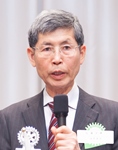The Latest Scientific Findings on Global Warming
March 2, 2016
Mr. Hiroki Kondo
Senior Advisor
Remote Sensing Technology Center of Japan
 We have come to witness violent weather escalating in its frequency and intensity in recent years. Tokyo suffered from an extreme heat wave last summer, followed by torrential rains in September that caused massive flooding damage.
We have come to witness violent weather escalating in its frequency and intensity in recent years. Tokyo suffered from an extreme heat wave last summer, followed by torrential rains in September that caused massive flooding damage.
The UN Conference on Climate Change (COP 21) was convened in Paris last December and adopted the Paris Agreement to take effect from 2020. The Agreement commits all countries to ��keep global temperature increases well below 2��C and to pursue efforts to limit it to 1.5��C�� as well as ��to review progress every five years.��
Climate is defined as the average weather over a period of time. It consists of several smaller subsystems (constituent elements) which influence each other to correct natural climate variability and keep a balance. Climate change is caused by natural variations, including solar output and volcanic activities. However, human activities which also cause climate change have come to give an enormous impact and disturb the balance. For example, the atmospheric CO2 concentration has been rising constantly since the 1950s. While the preindustrial CO2 concentration level in 1750 is estimated to be 278 ppm (parts per million), it increased by an alarming rate of 43% to reach a record-high 397.7 ppm in 2014. International society became concerned when studies indicated such an increase could trigger global warming.
The World Meteorological Organization (WMO) and the United Nations Environmental Program (UNEP) joined forces to establish the Intergovernmental Panel on Climate Change (IPCC). Its First Assessment Report was issued in 1990 and warned that ��there is considerable concern about the potential climatic effects that may result from increasing greenhouse-gas concentrations.�� The UN Framework Convention on Climate Change (UNFCCC) was adopted in 1992 which stipulated its ultimate objective in Article 2 as ��to achieve������ stabilization of greenhouse gas concentrations in the atmosphere at a level that would prevent dangerous anthropogenic interference with the climate system.��
The Fifth Assessment Report (AR5) of IPCC identified four possible climate futures, depending on how much greenhouse gases are emitted in the years to come. The four Representative Concentration Pathways (RCPs) are RCP 2.6, RCP 4.5, RCP 6.0 and RCP 8.5. The numbers refer to radiative forcing (RF) that warms up the Earth��s surface. Positive RF leads to surface warming and negative RF leads to surface cooling. AR5 concluded that ��warming of the climate system is unequivocal.�� Natural and anthropogenic substances and processes are drivers of climate change. Observation results indicate an accelerating increase in greenhouse gases (CO2, CH4, N2O) concentrations since 1750 as the world became industrialized.
While a part of the emitted anthropogenic CO2 has been stored on land (in plants and soils) and in the ocean, the rest has remained and accumulated in the atmosphere. The ocean has absorbed about 30% of the anthropogenic CO2, causing ocean acidification. The evidence for human influence on the rise in the global average surface temperature has grown since the previous Assessment Report (AR4) and AR5 concluded ��it is extremely likely (95%-100%)�� that increased anthropogenic greenhouse gas emissions have been the dominant cause of the observed warming.
Let me elaborate on the projected changes in the climate system. Of the four RCP scenarios, a global surface temperature increase is likely to stay below 2��C for RCP2.6 (low emission), making it the only scenario that conforms to the Paris Agreement. In the highest emission scenario RCP8.5, on the other hand, a temperature increase is projected to reach 4.3��C. Extreme weather and climate events will continue to escalate in frequency and intensity. For example, heat waves will occur with a higher frequency and longer duration, while occasional cold winter extremes continue to occur. The world��s oceans will continue to warm with the increase in ocean acidification. The Arctic sea ice will continue to reduce and could even disappear during the latter half of this century according to RCP8.5 scenario. Japan has the world��s leading climate change projection model that utilizes the Earth Simulator. Our research results have made a huge contribution to the development of AR5.
AR5 evaluates a 2��C temperature rise could impact the ecosystem and cultures as well as intensify extreme events such as heat waves, torrential rain and coastal flooding. A 4.3��C temperature rise will bring an enormous impact on both the Earth��s biodiversity and the overall global economy. AR5 enumerates various mitigation options to respond to different temperature increase projection scenarios, which are in line with the proposals of the First Assessment Report. Based on the findings of IPCC, policymakers concluded the Paris Agreement and resolved to make the temperature increase within 2��C and take even further measures to make it within 1.5��C so that the existence of small island states will not be threatened by climate change.
Countries around the world have already established its reduction target but that does not suffice. Fortunately, the Paris Agreement agreed to review progress every five years. I will keep a close eye on whether countries agree to make further commitment to mitigate and adapt to climate change in five years�� time.